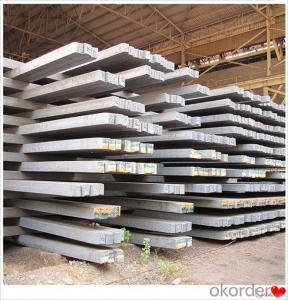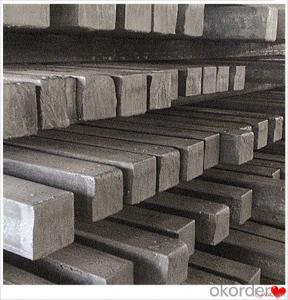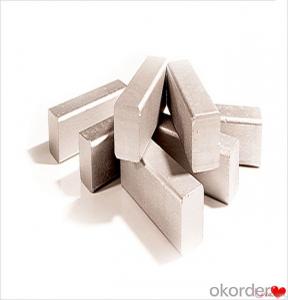Mild Steel Billet Q235,Q255,Q275,Q345,3SP,5SP,20MnSi Chinese Supplier
- Loading Port:
- China main port
- Payment Terms:
- TT OR LC
- Min Order Qty:
- 20 m.t.
- Supply Capability:
- 200000 m.t./month
OKorder Service Pledge
OKorder Financial Service
You Might Also Like
Mild Steel Billet Q235,Q255,Q275,Q345,3SP,5SP,20MnSi Chinese Supplier
Specification
Steel billet(ingot) by cogging or breakdown of semi-finished products, is the raw material of all kinds of steel mill. Billet section of square, round, flat, rectangular and abnormity of several kinds of, mainly related to the shape of rolled products.
CNBM Q235,Q275,Q345,3SP,5SP,20MnSi Billets Steel in Hot Sale
Hot Rolled Steel Billets/ Mild Steel Bar/ Billet Steel Prime Steel Billet
Specification (see below)
Standard: GB/JIS/ASTM
Size: 50*50mm-180*180mm
Length: 3-12mtrs or Customised
Steel material: Q235,Q255,Q275,Q345,3SP,5SP,20MnSi
Technique: Hot rolled
FOB Unit Ton Price $250-350 and Usually I will quote you CFR price.
MOQ: Usually 1000-10000MT/size
Shipment:By Container,Bulk Vessel
Packaging Details: bundles with steel strips or as customers's requirements
Delivery time: Usually within 30 days after the deposit/LC
Inspection:Third party inspection before loading.
Technical data
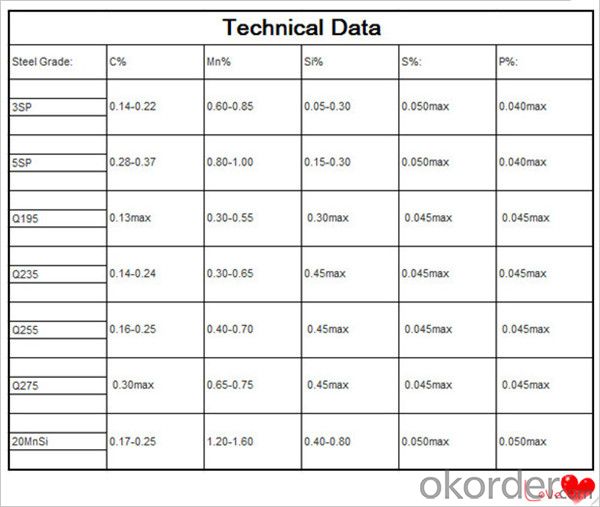
Feature Steel Billet
Rectangular billet continuous casting billet and mainly general carbon steel, low carbon low silicon cold-rolled material, high quality carbon structural steel, high strength low alloy steel, special steel, etc.
The billet is mainly divided into two kinds from the shape:
Slab: cross section width and height of the ratio of the larger, mainly used for rolling plate.
Billet: equal cross section width and height, or a huge difference, mainly used for rolling steel, wire rod. ,
Steel billets have distinct characteristics as compared with already furnished steel bars and products. Billets have a specific grain structure, which enables the metal to be processed more intricately. Steel billets are also known for their malleability and ductility, especially when exposed to varying temperatures during shaping and molding.
Packaging & Shipping
1. Packaging:
1) Small size: in bundles
2)Big size: in bulk
3)in plastic packing or as per customer requirement
2. Delivery time:
1) Normal size: within 7days send from warehouse directly
2) Special size: with 25-30days customer made for you
3. Trade terms:FOB/CFR/CIF
4. Shippment:
1) length:≤5.8m loaded in 20FT Container with 25-27tons
2) length:≤11.8m loaded in 40FT Container with 25-27tons
3) lengnth:≥12m shipped by bulk vessel, FILO terms
Steel Billet Images
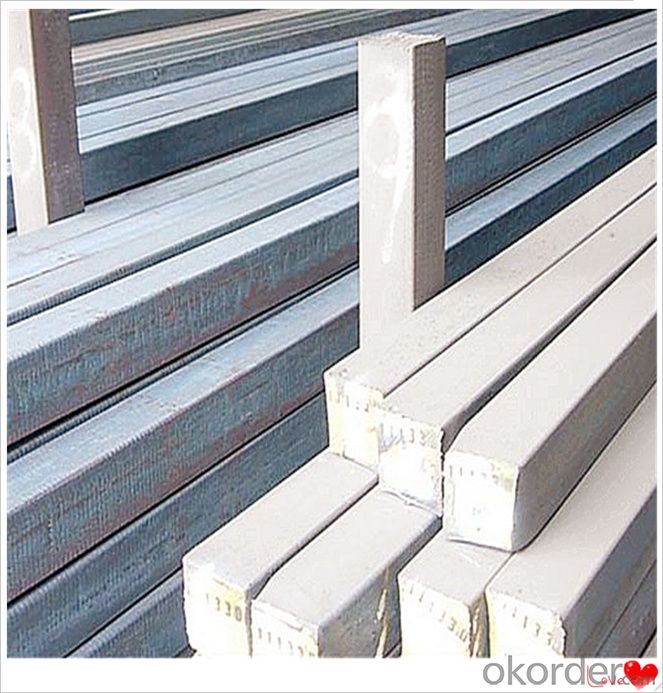
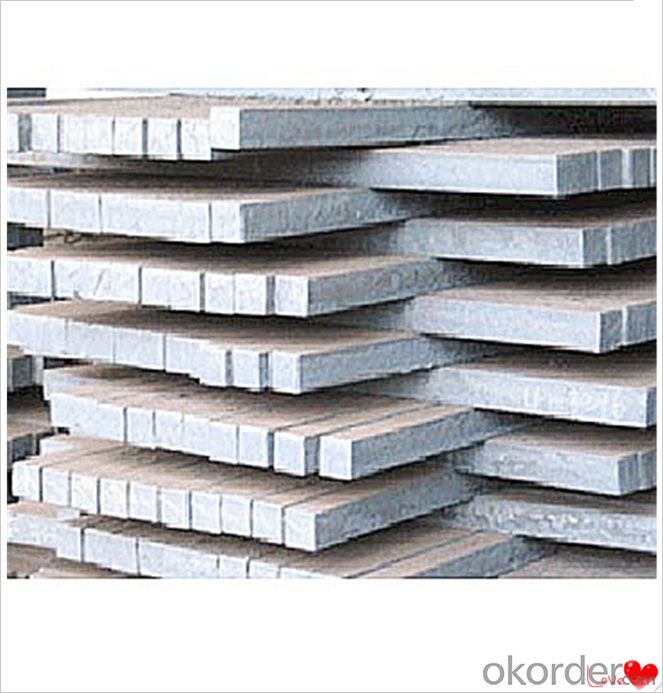
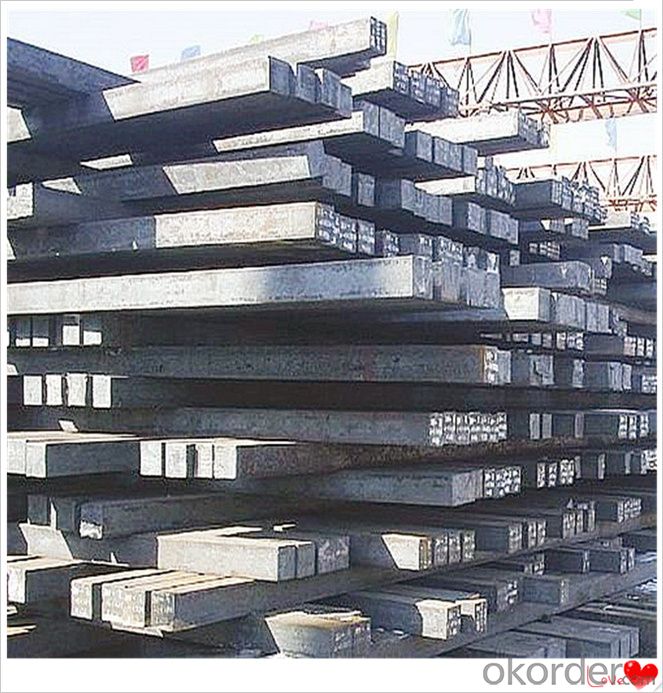

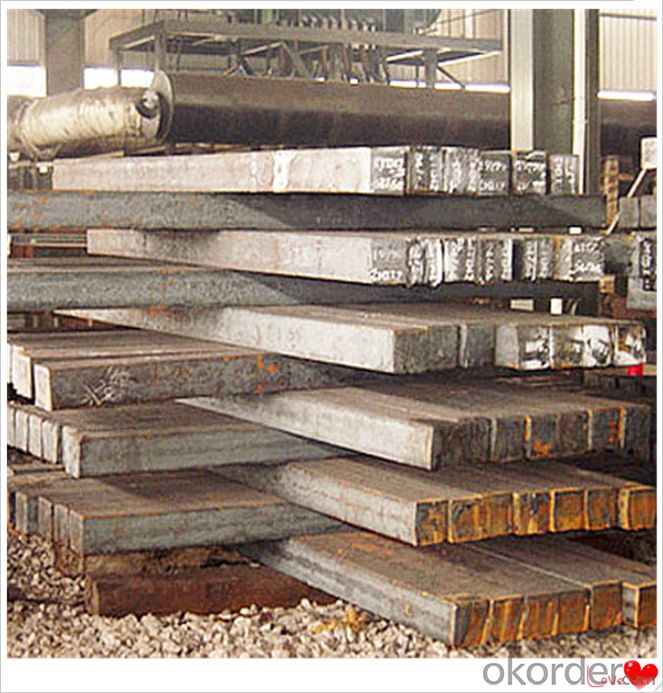
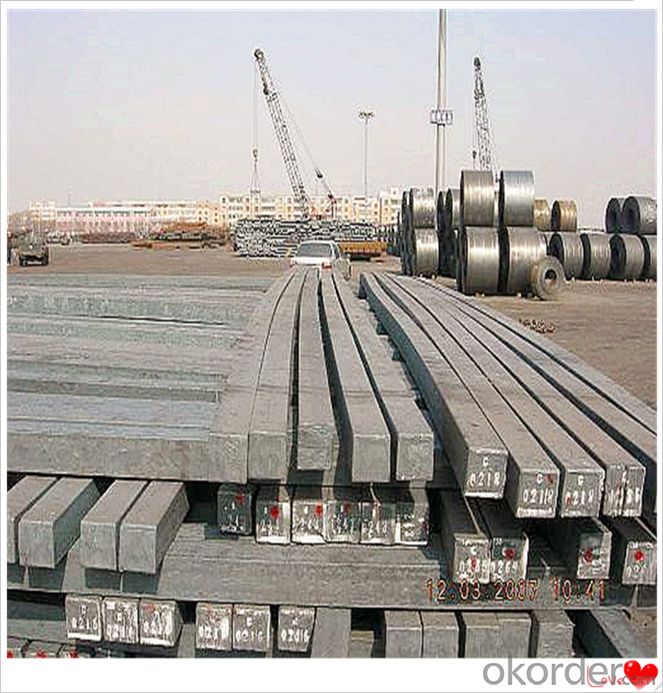
Processing
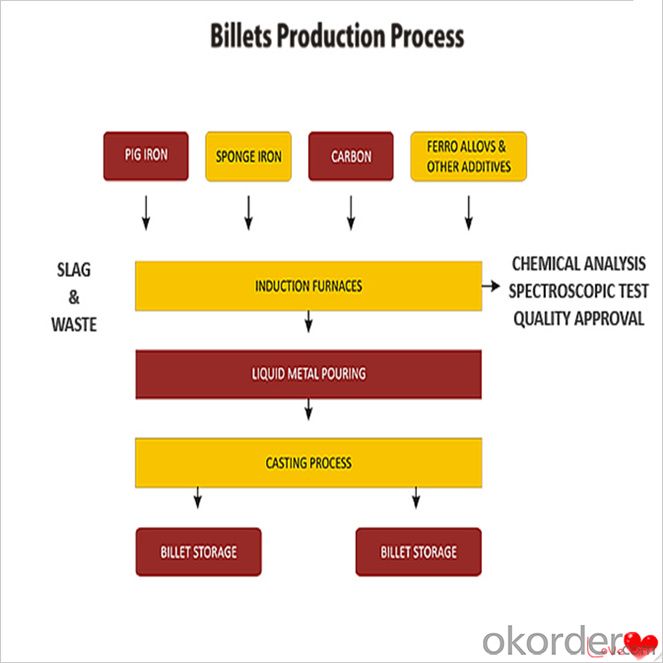
Usage-Billet Steel
Used for the plant, the bridge,shipment building high-rise building construction,lifting and transportation machinery, equipment manufracturing base building the support foundation pile manufacturing.
Billets, or ingots (as they sometimes referred to), are not of practical use until they have been formed into more functional shapes and sizes. While they have already been put in the furnace, they still require a series of shaping and molding procedures such as hot and cold working, milling and cutting before they are sold in hardware stores, or used for different applications. The unformed billets, however, can be used in striking currency such as coins and as reserves, similar to gold bars.
FAQ-Billet Steel
We have organized several common questions for our clients,may help you sincerely:
1) How about your company?
A world class manufacturer & supplier of castings forging in carbon steel and alloy steel,is one of the large-scale professional investment casting production bases in China,consisting of both casting foundry forging and machining factory. Annually more than 8000 tons Precision casting and forging parts are exported to markets in Europe,America and Japan. OEM casting and forging service available according to customer’s requirements.
2) How to guarantee the quality of the products?
We have established the international advanced quality management system,every link from raw material to final product we have strict quality test;We resolutely put an end to unqualified products flowing into the market. At the same time, we will provide necessary follow-up service assurance.
3) How long can we receive the product after purchase?
In the purchase of product within three working days, We will arrange the factory delivery as soon as possible. The pecific time of receiving is related to the state and position of customers.Commonly 7 to 10 working days can be served.
4)Do you have your own QC department?
Yes, we have, our QC department will inspect the goods during the process of mass production and after completion of production.
hot sale!!! Cast Steel Grades/ mild steel bar/ billet steel
(1): High quality steel with reasonable price.
(2): Wide excellent experiences with after-sale service.
(3): Every process will be checked by responsible QC which insures every product's quality.
(4): Professional packing teams which keep every packing safely.
(5): Trial order can be done in one week.
(6): Samples can be provided as your requirements.
- Q:What are the different types of steel billet cutting defects?
- Some common types of steel billet cutting defects include burrs, cracks, uneven cuts, surface imperfections, and excessive material loss.
- Q:What are the different methods of steel billet surface honing?
- There are several different methods of steel billet surface honing, each serving a specific purpose and achieving different results. Some of the common methods include: 1. Manual Honing: This traditional method involves using hand-held honing tools, such as stones or abrasive pads, to manually remove any imperfections or rough surfaces from the steel billet. Skilled operators carefully rub the honing tool along the surface of the billet until the desired smoothness is achieved. 2. Mechanical Honing: In this method, mechanical honing machines are used to automate the honing process. These machines are equipped with rotating abrasive stones or pads that move along the surface of the billet, removing any irregularities. Mechanical honing allows for a more consistent and precise honing process, with the ability to control factors such as pressure, speed, and contact area. 3. Diamond Honing: Diamond honing is a specialized method that utilizes diamond-coated tools to achieve a high level of precision and smoothness. The diamond particles on the honing tool provide superior cutting capabilities, allowing for the removal of even the smallest imperfections. This method is often used for honing high-quality steel billets that require a flawless surface finish. 4. Hydrohoning: Hydrohoning, also known as abrasive flow machining, involves using a viscous abrasive medium that is forced through the billet's internal passages to remove any surface irregularities. This method is especially effective for honing complex shapes or internal surfaces that are difficult to reach through other methods. The abrasive medium can be adjusted to achieve different levels of surface finish. 5. Electrochemical Honing: Electrochemical honing is a technique that combines the principles of electrochemical machining and honing. It involves using a special electrolyte solution and a honing tool with an electrode to remove material from the billet's surface. This method is effective for honing hard materials and achieving a smooth, mirror-like finish. These are just some of the different methods of steel billet surface honing. The choice of method depends on factors such as the desired surface finish, the complexity of the billet's shape, the material being honed, and the level of precision required.
- Q:How are steel billets used in the production of automotive suspension components?
- Steel billets are used in the production of automotive suspension components due to their strength, durability, and malleability. Billets are essentially semi-finished steel products that are formed into specific shapes, such as bars or rods, through a process called hot rolling. In the case of automotive suspension components, steel billets are first heated to a high temperature and then passed through a series of rollers to shape them into the desired form, such as coil springs, shock absorber rods, or stabilizer bars. The hot rolling process helps to refine the grain structure of the steel, resulting in improved mechanical properties. The use of steel billets in suspension components is crucial as they provide the necessary strength and stiffness to withstand the various forces and loads encountered during vehicle operation. Suspension components, such as coil springs, are responsible for supporting the weight of the vehicle and providing a comfortable ride by absorbing impacts and vibrations. Steel billets are preferred for automotive suspension components due to their high tensile strength, which allows them to withstand heavy loads and maintain their shape over long periods. Additionally, the malleability of steel allows for easy forming and shaping into various complex geometries, ensuring a precise fit and functionality within the suspension system. Moreover, steel billets offer excellent fatigue resistance, which is crucial for suspension components as they undergo repetitive loading and unloading throughout the vehicle's lifespan. This fatigue resistance helps to prevent failure and ensures a long-lasting and reliable suspension system. Overall, the use of steel billets in the production of automotive suspension components is essential for achieving the necessary strength, durability, and performance required for safe and comfortable vehicle operation.
- Q:What are the different types of steel billet defect detection methods?
- The industry commonly utilizes various steel billet defect detection methods to ensure the production of high-quality products. These methods help identify defects or imperfections in the steel billets. Some of the methods include: 1. Visual Inspection: Trained inspectors visually examine the billets for visible defects, such as cracks, surface irregularities, or deformations. While effective for certain defects, internal or hidden defects may go undetected. 2. Ultrasonic Testing: High-frequency sound waves are used to detect defects within the billets. Any disruptions in the waves indicate the presence of defects like cracks or voids. This technique is widely used for detecting internal defects. 3. Magnetic Particle Inspection: The steel billet is magnetized, and iron particles are applied. If there are surface or near-surface defects, the particles are attracted to these areas, making the defects visible. This method is useful for detecting surface cracks and discontinuities. 4. Eddy Current Testing: Electromagnetic induction is utilized to detect surface or near-surface defects. By placing a coil carrying an alternating current near the billet, changes in electrical conductivity or magnetic properties caused by defects are detected. Eddy current testing is particularly effective for detecting surface cracks and corrosion. 5. X-ray Testing: X-ray radiation is passed through the steel billet, and the resulting image is captured on a film or digital detector. Dark spots on the X-ray image indicate internal defects like cracks, voids, or inclusions. This method is highly effective for detecting internal defects. 6. Laser Scanning: A laser scanner is used to create a three-dimensional image of the steel billet's surface. Specialized software is employed to detect and analyze any irregularities or deformations in the surface. Laser scanning is a precise and efficient method for detecting surface defects. These are just a few of the steel billet defect detection methods commonly used in the industry. Each method has its own advantages and limitations, and the choice depends on factors like the type of defect, billet size and shape, and required precision. Employing these methods ensures the production of high-quality steel products.
- Q:How are steel billets forged into shape?
- Steel billets are forged into shape through a process called hot forging, which involves heating the billet to a specific temperature and then applying pressure to shape it using a forging press or hammer. This process helps to refine the grain structure of the steel, improving its strength and mechanical properties.
- Q:What is the typical size and shape of steel billets?
- The typical size and shape of steel billets can vary depending on the specific application and industry requirements. However, they are commonly rectangular or square in shape, with dimensions ranging from a few inches to several feet in length, width, and height.
- Q:How do steel billets contribute to the manufacturing of rail and transportation systems?
- Steel billets are crucial in the manufacturing process of rail and transportation systems. These billets serve as the primary material used to produce various components needed for railway construction, including rails, sleepers, and fasteners. One of the main applications of steel billets in rail manufacturing is for the creation of railway tracks. Initially, the steel billets are heated and then rolled into long, slim sections known as rails. These rails undergo further processing and treatment to endure the heavy loads and constant wear and tear experienced in railway operations. The durability, strength, and resistance to deformation of steel make it a perfect material for railway tracks, ensuring transportation safety and efficiency. Steel billets also have a vital role in the manufacturing of sleepers or railroad ties, which provide support to the rails and maintain their alignment. These sleepers, typically made from prestressed concrete or wood, require reinforcing bars made from steel billets to enhance their strength and structural integrity. Additionally, steel billets are used to produce fasteners like bolts, clips, and spikes, which are essential for securely attaching rails to sleepers and maintaining track stability. Furthermore, steel billets are utilized in the production of various components for transportation systems, including chassis, frames, and suspension systems for trains, trams, buses, and other vehicles. The high strength and excellent formability of steel billets make them an ideal choice for these applications, as they can withstand heavy loads and provide the necessary structural integrity for safe and reliable transportation. To conclude, steel billets play a significant role in the manufacturing of rail and transportation systems. From railway track production to the fabrication of sleepers, fasteners, and vehicle components, steel billets offer the required strength, durability, and structural integrity for the efficient and safe operation of railways and transportation systems.
- Q:Are steel billets susceptible to corrosion?
- Steel billets can be affected by corrosion. Steel, which is mostly made up of iron and carbon, is prone to corrosion because of the presence of iron. When exposed to moisture and oxygen, a chemical reaction occurs on the surface of the steel, resulting in the formation of rust, also known as iron oxide. This corrosion weakens the structure of the steel and can eventually cause it to fail. To prevent corrosion, protective layers are often applied or anti-corrosion agents are used on steel billets. Common methods include galvanizing, where a layer of zinc is added, or coating the steel with paint or epoxy. Additionally, storing steel billets in dry environments and ensuring proper ventilation can help reduce the risk of corrosion. It's worth noting that the susceptibility to corrosion can also depend on the specific composition and grade of the steel used in the billets. Certain types of stainless steel, for example, contain additional elements such as chromium and nickel, which offer improved resistance to corrosion. However, even stainless steel can corrode under certain conditions, although at a slower rate compared to regular carbon steel. Regular inspection, maintenance, and appropriate corrosion prevention measures are essential in ensuring the long-lasting durability of steel billets.
- Q:What are the common defects found in steel billets?
- There are several common defects that can be found in steel billets. These defects can occur during the manufacturing process or due to external factors. One common defect is surface cracks, which can occur due to improper cooling, handling, or excessive stress during rolling or forming. These cracks can weaken the billet and affect its overall strength and integrity. Another common defect is internal voids or inclusions, which can occur due to the presence of impurities or foreign particles in the steel. These voids can create weak spots in the billet and can lead to structural failures or reduced mechanical properties. Misalignment or misshaping is another defect that can occur during the cooling or forming process. This defect can result in uneven thickness or dimensions, which can compromise the billet's performance and suitability for its intended application. In addition, excessive segregation of alloying elements can occur, leading to uneven distribution of properties within the billet. This can result in inconsistent mechanical properties and reduced overall quality. Lastly, surface defects such as scale, pitting, or surface imperfections can also be found in steel billets. These defects can occur due to improper handling, storage, or exposure to harsh environments. While these defects may not affect the structural integrity of the billet, they can impact the surface finish and aesthetics of the final product. Overall, it is essential to identify and address these common defects in steel billets to ensure the production of high-quality and reliable steel products. Regular inspections, quality control measures, and proper handling and storage techniques can help minimize and prevent these defects.
- Q:What is the difference between continuous casting billet and cast billet?
- Mainly to see the process, general casting efficiency is low, but the quality is acceptable, with low level (open casting billet) has great advantages in surface quality;
1. Manufacturer Overview |
|
|---|---|
| Location | |
| Year Established | |
| Annual Output Value | |
| Main Markets | |
| Company Certifications | |
2. Manufacturer Certificates |
|
|---|---|
| a) Certification Name | |
| Range | |
| Reference | |
| Validity Period | |
3. Manufacturer Capability |
|
|---|---|
| a)Trade Capacity | |
| Nearest Port | |
| Export Percentage | |
| No.of Employees in Trade Department | |
| Language Spoken: | |
| b)Factory Information | |
| Factory Size: | |
| No. of Production Lines | |
| Contract Manufacturing | |
| Product Price Range | |
Send your message to us
Mild Steel Billet Q235,Q255,Q275,Q345,3SP,5SP,20MnSi Chinese Supplier
- Loading Port:
- China main port
- Payment Terms:
- TT OR LC
- Min Order Qty:
- 20 m.t.
- Supply Capability:
- 200000 m.t./month
OKorder Service Pledge
OKorder Financial Service
Similar products
New products
Hot products
Related keywords
